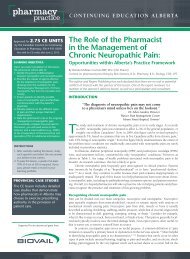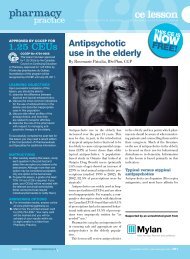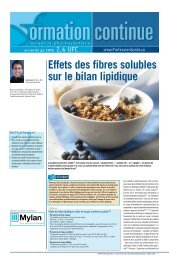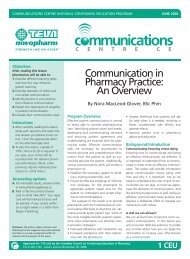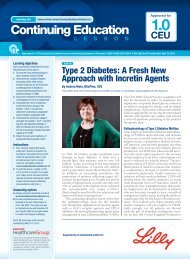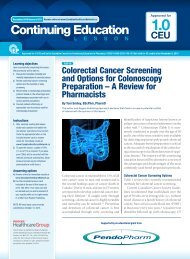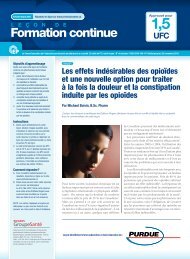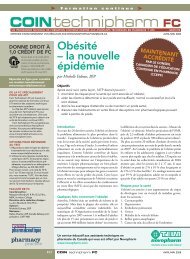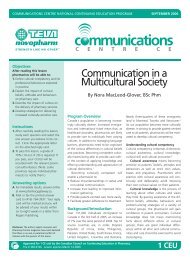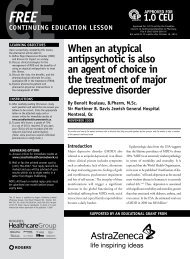cece lesson
cece lesson
cece lesson
You also want an ePaper? Increase the reach of your titles
YUMPU automatically turns print PDFs into web optimized ePapers that Google loves.
ce <strong>lesson</strong>Pharmacy Practice national continuing education programA Pharmacist’s Overview of Alcohol Dependence: The Path to AbstinencePharmacotherapy ofconcurrent alcoholdependence anddepressionSelective serotonin reuptakeinhibitors (SSRIs)SSRIs increase serotonin levels by inhibitingserotonin reuptake at the synapse.SSRIs may indirectly improve patientoutcomes in alcohol dependence treatment(e.g., abstinence) by increasingserotonin levels, thus alleviating underlyingdepression. (10) Fluoxetine, sertraline,and citalopram have been studied inclinical trials, with sertraline also impactingon dopamine as well as serotonin.However, the evidence to support theirefficacy is weak. (10)QuetiapineQuetiapine is an atypical antipsychoticwith multiple receptor affinities (predominatelyserotonin and dopamine), whichmay be beneficial in alcohol dependencetreatment. (27) One hypothesis suggestsquetiapine’s benefit is secondary to thestructural similarity of one of its metabolitesto methadone, which may subsequentlyact as a pleasure-reward modulator.(37) Additional effects of quetiapine ondrinking outcomes may be related to itsbeneficial effects on mood, anxiety andsleep, which may help alleviate protractedwithdrawal symptoms as well as addressco-morbidities. 3 The efficacy of quetiapinein treating alcohol dependence was demonstratedin a small placebo-controlledtrial, but further research is warranted. (38)table 6Additional Resources for Pharmacists and PatientsHealth Canada – Alcohol & Drug and Prevention PublicationsA useful website for pharmacists containing information about youth, seniors andspecial populations with alcohol and substance abuse, including rehabilitation.www.hc-sc.gc.ca/hc-ps/pubs/adp-apd/index-eng.phpAlcoholics Anonymous/Al-Anon/AlateenResources for patients and family members seeking support while drinking or when inrecovery.www.alcoholics-anonymous.org; www.al-anon.alateen.org/Centre for Addiction and Mental Health (CAMH)A comprehensive resource for patients interested in learning more about alcoholdependence including diagnosis, impacts, rehabilitation and recovery.www.camh.net/About_Addiction_Mental_Health/AMH101/top_searched_alcohol.htmlNational Institute on Alcohol Abuse and AlcoholismA resource for healthcare professionals including clinical guidelines, pamphlets,brochures and research for helping patients with alcohol dependence.www.niaaa.nih.gov/Pages/default.aspxMedlinePlus (National Institutes of Health) – Alcoholism and Alcohol AbuseAn overview of alcoholism and alcohol abuse for patients, including symptoms, causes,diagnosis, treatment, complications, and support groups.www.nlm.nih.gov/medlineplus/ency/article/000944.htmThe Definition of AddictionA detailed resource for pharmacists addressing alcohol dependence, withdrawalsymptoms, post-acute withdrawal syndrome, and approaches to recovery.www.addictionsandrecovery.org/definition-of-addiction.htmMotheriskA helpful resource and reference with articles for patients and healthcare professionalson the use of alcohol during pregnancy and breastfeeding.www.motherisk.org/women/alcohol.jspProfessionals Health ProgramA resource for pharmacists interested in learning more about the Ontario ProfessionalsHealth Program and its confidential services to assist members suffering from incapacitation,substance use and/or mental health issues.www.ocpinfo.com/client/ocp/OCPHome.nsf/web/ Professionals+Health+ProgramGuidelines for Handling Incapacitated Pharmacists and Pharmacy Co-workersAn Ontario College of Pharmacists document outlining warning signs, duty to report (withscenarios) and the definition and guidelines in defining the “incapacitated pharmacist.”www.phpoma.org/PDF%20files/Pharmacist/ Guidelines_for_Handling_Incapacity.pdfCommunication skills inalcohol dependenceCounselling the patient with alcohol dependencerequires awareness on the part of thepharmacist to ensure that any barriers—including environmental, personal biases,patient, time and behavioural—are removedor minimized. These barriers contribute to90% of the nonverbal communication thatis transferred to the patient. We must beaware of our own belief systems and culturalawareness about alcohol use prior to engagingin dialogue. (39) Awareness of this phenomenonwill diminish the chance of “scolding”or “lecturing” the patient, actions thatadd to their guilt, and shame, which mayincrease the risk of failure of treatment.Empathy and empowerment are keys toprevent adding further “dis-ease” to thedisease of alcohol dependence. Helpfulresources for pharmacists and patients/families are presented in Table 6.MonitoringPhysiological ParametersTLab tests such as liver function tests,mean corpuscle volume, serum alcohollevels, urine specific gravity and bilirubinare usually elevated in a patient whochronically consumes alcohol, while serumB12 and folate are commonly depleted.Test results within normal ranges may provideevidence of continued abstinence,although not definitive. This is coupledwith the patient and family member’supdates to quantify stable recovery. Insome cases, random urine toxicologyscreening may be performed. (40)Psychological ParametersIt is essential for the pharmacist to continuallyquantify and discuss drinkingCE6 pharmacypractice | december 2011answer online at canadianhealthcarenetwork.ca



